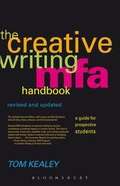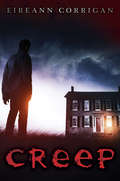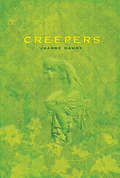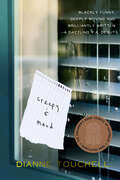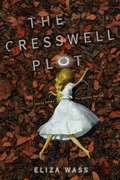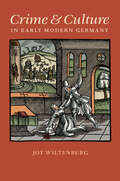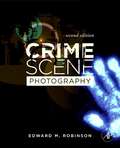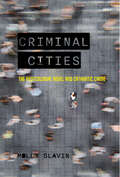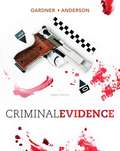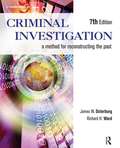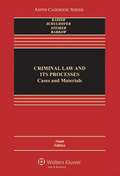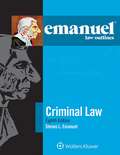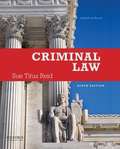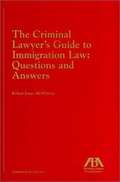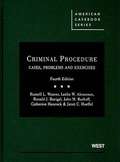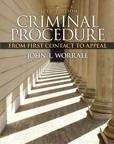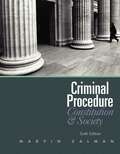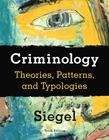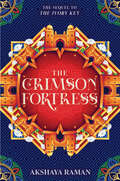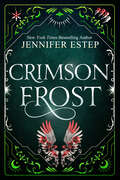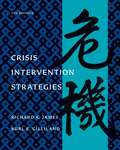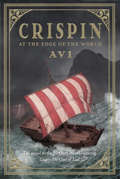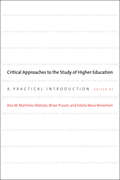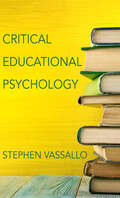- Table View
- List View
Creative Writing MFA Handbook: A Guide for Prospective Graduate Students (2nd Edition)
by Tom KealeyRevised and Updated! The Creative Writing MFA Handbook guides prospective graduate students through the difficult process of researching, applying to, and choosing graduate schools in creative writing. The handbook includes profiles of fifty creative writing programs, guidance through the application process, advice from current professors and students including George Saunders, Aimee Bender, Tracy K. Smith, and Geoffrey Wolff, and the most comprehensive listings of graduate writing programs in and outside the United States. The handbook also includes special sections about Low-Residency writing programs, Ph. D. programs, publishing in literary journals, and workshop and teaching advice. In a remarkably concise, user-friendly fashion,The Creative Writing MFA Handbook answers as many questions as possible, and is packed with information, advice, and experience. This second edition updates and builds upon the first edition, which was published in 2005 to great acclaim and contains a vastly expanded ranking of current creative writing programs.
Creep
by Eireann CorriganThe haunting tale of a family that moves into a house... and finds that someone -- or something -- does NOT want them there.Olivia is curious about the people moving into 16 Olcott Place. The last family there moved out in the dead of night, and the new family, the Donahues, has no idea why. Olivia becomes fast friends with Janie Donahue . . . so she's there at the house when the first of the letters arrives:--I am the Sentry of Glennon Heights. Long ago I claimed 16 Olcott Place as levy for my guardianship. The walls will not tolerate your trespass. The ceilings will bleed and the windows will shatter. If you do not cease your intrusion, the rooms will soon smell of corpses.--Who is the Sentry? And why does the Sentry want the Donahues out of the house badly enough to kill? As Olivia and Janie explore the house, they find a number of sinister secrets . . . and as they explore their town, they find a hidden history that the Sentry wants to remain hidden forever. You can lock the doors. You can close the windows. But you can't keep the Sentry out. . . .
Creepers
by Joanne DahmeFrom moving to a new house to making new friends and preparing for high school, life for the new girl in town can be unsettling. But thirteen year-old Courtney is unprepared for how creepy life in Murmur, Massachusetts turns out to be. Her ivy-covered house overlooking the antiquated cemetery next door is one thing, but Courtney finds herself thrust into a full-fledged haunted adventure after meeting Christian and Margaret Geyer, a strange father and daughter with unfinished family business. The body of their ancestor, Prudence, has gone missing from beneath her ivy-carved tombstone and must be returned to its final resting place in order to break the spell that looms over Courtney's house. To add to the suspense and help solve the mystery, authentic documents and photographs are set at the beginning of each chapter pertaining to Murmur, Courtney's house, and the infamous cemetery. Will Courtney uncover the secret lurking within the dark, dank underbelly of her ivy-covered basement?
Creepy & Maud
by Dianne TouchellHilarious and heartbreaking, Creepy & Maud charts the relationship between two social misfits, played out in the space between their windows. Creepy is a boy who watches from the shadows keenly observing and caustically commentating on human folly. Maud is less certain. A confused girl with a condition that embarrasses her parents and assures her isolation. Together Creepy and Maud discover something outside their own vulnerability — each other's. But life is arbitrary; and loving someone doesn't mean you can save them. Creepy & Maud is a blackly funny and moving first novel that says; 'You're ok to be as screwed up as you think you are and you're not alone in that.'
The Cresswell Plot
by Eliza WassThe woods were insane in the dark, terrifying and magical at the same time. But best of all were the stars, which trumpeted their light into the misty dark. Castella Cresswell and her five siblings???Hannan, Casper, Mortimer, Delvive, and Jerusalem??? know what it's like to be different. For years, their world has been confined to their ramshackle family home deep in the woods of upstate New York. They abide by the strict rule of God, whose messages come directly from their father. Slowly, Castley and her siblings start to test the boundaries of the laws that bind them. But, at school, they're still the freaks they've always been to the outside world. Marked by their plain clothing. Unexplained bruising. Utter isolation from their classmates. That is, until Castley is forced to partner with the totally irritating, totally normal George Gray, who offers her a glimpse of a life filled with freedom and choice. Castley's world rapidly expands beyond the woods she knows so well and the beliefs she once thought were the only truths. There is a future waiting for her if she can escape her father's grasp, but Castley refuses to leave her siblings behind. Just as she begins to form a plan, her father makes a chilling announcement: the Cresswells will soon return to their home in heaven. With time running out on all of their lives, Castley must expose the depth of her father's lies. The forest has buried the truth in darkness for far too long. Castley might be their last hope for salvation.
Crime and Culture in Early Modern Germany (Studies in Early Modern German History)
by Joy WiltenburgWith the growth of printing in early modern Germany, crime quickly became a subject of wide public discourse. Sensational crime reports, often featuring multiple murders within families, proliferated as authors probed horrific events for religious meaning. Coinciding with heightened witch panics and economic crisis, the spike in crime fears revealed a continuum between fears of the occult and more mundane dangers.In Crime and Culture in Early Modern Germany, Joy Wiltenburg explores the beginnings of crime sensationalism from the early sixteenth century into the seventeenth century and beyond. Comparing the depictions of crime in popular publications with those in archival records, legal discourse, and imaginative literature, Wiltenburg highlights key social anxieties and analyzes how crime texts worked to shape public perceptions and mentalities. Reports regularly featured familial destruction, flawed economic relations, and the apocalyptic thinking of Protestant clergy. Wiltenburg examines how such literature expressed and shaped cultural attitudes while at the same time reinforcing governmental authority. She also shows how the emotional inflections of crime stories influenced the growth of early modern public discourse, so often conceived in terms of rational exchange of ideas.
Crime Scene Photography (Second Edition)
by Edward M. RobinsonCrime Scene Photography, Second Edition covers the general principals and concepts of photography, while also delving into the more practical elements and advanced concepts of forensic photography. Edward Robinson assists the reader in understanding and applying essential concepts in order to create images that are able to withstand challenges in court. The first part of the book deals with the basic theory and science of photography required to take superior photographs, and covers topics such as composition, exposure, focus, depth of field, and flash techniques. The second part of the text deals specifically with the challenges of photographing a crime scene, including instructions on how to document bodies and wounds, traffic accident photography, underwater photography and aerial photography. In the latter portions of the text, the author turns to digital theory and its advantages and disadvantages. * Over 600 full color photographs, also electronically available on the companion website * Two new chapters on 'The History of Forensic Photography,' and 'Digital Image Processing of Evidentiary Photography' * Includes an Instructor website with lecture slides, practical exercises, a test bank and image collection * An essential reference for crime scene photography, including topics such as Composition, the Inverse Square Law, Court Cases affecting photography, Digital Image Processing, and Photogrammetry * Required reading by the Crime Scene Certification Board of the International Association for Identification (IAI) for all levels of certification
Criminal Cities: The Postcolonial Novel and Cathartic Crime (Cultural Frames, Framing Culture)
by Molly SlavinWhy does crime feature at the center of so many postcolonial novels set in major cities? This book interrogates the connections that can be found between narratives of crime, cities, and colonialism to bring to light the ramifications of this literary preoccupation, as well as possibilities for cultural, aesthetic, and political catharsis.Examining late-twentieth- and twenty-first-century novels set in London, Belfast, Mumbai, Sydney, Johannesburg, Nairobi, and urban areas in the Palestinian West Bank, Criminal Cities considers the marks left by neocolonialism and imperialism on the structures, institutions, and cartographies of twenty-first-century cities. Molly Slavin suggests that literary depictions of urban crime can offer unique capabilities for literary characters, as well as readers, to process and negotiate that lingering colonial violence, while also providing avenues for justice and forms of reparations.
Criminal Evidence (Eighth Edition)
by Thomas Gardner Terry AndersonWhat makes evidence admissible or inadmissible in court? You'll know the answer once you read CRIMINAL EVIDENCE: PRINCIPLES AND CASES, 8th Edition. Whatever your future career in the justice system, this book outlines all you need to know about criminal evidence and its use. Packed with stories and cases as well as the most up-to-date legal information available, it's the most relevant and engaging resource of its kind.
Criminal Investigation: A Method For Reconstructing the Past (Seventh Edition)
by James W. Osterburg Richard H. WardThis text presents the fundamentals of criminal investigation and provides a sound method for reconstructing a past event (i. e. , a crime), based on three major sources of information -- people, records, and physical evidence. Its tried-and-true system for conducting an investigation is updated with the latest techniques available, teaching the reader new ways of obtaining information from people, including mining the social media outlets now used by a broad spectrum of the public; how to navigate the labyrinth of records and files currently available online; and fresh ways of gathering, identifying, and analyzing physical evidence.
Criminal Law: Cases, Materials, and Lawyering Strategies
by David Crump Neil P. Cohen John T. Parry Penelope PetherThis casebook contains all of the subjects that ought to be covered in a first course in Criminal Law. The elements of crimes, actus reus and mens rea receive thorough coverage. The basic crimes, including homicide, sexual assault (or rape), theft, and related offenses, are there. The book covers multiple party crimes and preparatory offenses. Sentencing receives a major chapter. And the justification and legality of the criminal law, including constitutional limits on crime definition and the relationship between crimes, harm, and morals, are all covered.
Criminal Law and Its Processes: Cases and Materials (Ninth Edition)
by Sanford H. Kadish Stephen J. Schulhofer Rachel E. BarkowThis teaching guide helps law student students establish a solid foundation in the processes of criminal law and understanding of the problems within. This revised edition has enhanced details on group criminality, international human rights, human trafficking etc.
Criminal Law (Emanuel Law Outlines): Eighth Edition
by Steven EmanuelThe most trusted name in law school outlines, Emanuel Law Outlines were developed while Steve Emanuel was a student at Harvard Law and were the first to approach each course from the point of view of the student. Invaluable for use throughout your course and again at exam time, Emanuel Law Outlines are well-correlated to all major casebooks to help you to create your own outlines. Sophisticated yet easy to understand, each guide includes both capsule and detailed explanations of critical issues, topics, and black letter law you must know to master the course. Quiz Yourself Q&As, Essay Q&As, and Exam Tips give you ample opportunity to test your knowledge throughout the semester and leading up to the exam. Every title in the series is frequently updated and reviewed against new developments and recent cases covered in the leading casebooks. Emanuel Law Outlines provide a comprehensive breakdown of the law, more sweeping than most, for your entire study process. For more than thirty years, Emanuel Law Outlines have been the most trusted name in law school outlines. Here s why: Developed by Steve Emanuel when he was a law school student at Harvard, Emanuel Law Outlines became popular with other law students and spawned an industry of reliable study aids. (Having passed the California bar as well, Steve Emanuel is now a member of the New York, Connecticut, Maryland, and Virginia bars. ) Each Outline is valuable throughout the course and again at exam time. Outline chapters provide comprehensive coverage of the topics, cases, and black letter law covered in the course and major casebooks, written in a way you can easily understand. The Quiz Yourself Q&A in each chapter and the Essay Q&A at the end provide ample opportunity to test your knowledge throughout the semester. Exam Tips alert you to the issues that commonly pop up on exams and to the fact patterns commonly used to test those items. The Capsule Summary an excellent exam preparation tool provides a quick review of the key concepts covered in the course. The comprehensive coverage is more sweeping than most outlines. Each Emanuel Law Outline is correlated to the leading casebooks. Every title is frequently updated and reviewed against new developments and recent cases covered in the leading casebooks. Tight uniformity of writing style and approach means that if you use one of these guides, you can be confident that the others will be of similar quality.
Criminal Law, Ninth Edition
by Sue Titus ReidOffering a unique modified case approach, Criminal Law, Ninth Edition, uses a wide sampling of federal and state statutes and cases to provide students with a comprehensive and contemporary introduction to the field. This ninth edition features the most recent relevant court decisions, especially those of the U.S. Supreme Court, along with current events and updates, where available, on topics retained from the previous edition.
The Criminal Lawyer's Guide to Immigration Law: Questions and Answers
by Robert James McwhirterSet up in a unique question and answer format, this concise guide focuses on the criminal lawyer's most common questions about immigration law and representing noncitizens.
Criminal Procedure: Cases, Problems and Exercises (4th edition)
by Russell L. Weaver Leslie W. AbramsonThe fourth edition contains thought-provoking problems, and is designed to encourage classroom discussion, and help students effectively learn criminal procedure principles. Ideally suited for a one-semester course, this casebook contains all the essential decisions without being overwritten or so massive as to be unwieldy. in addition, the new edition is completely up-to-date containing the latest decisions from the United States Supreme Court, as well as problems based on important lower court decisions. Criminal Procedure: Cases, Problems and Exercises is unique because the authors actively seek to place students in situations that they are likely to encounter in practice, and asks students to think about how they might handle those situations (e. g. , what does a lawyer do when asked to represent a client at a lineup?). for this new edition, the authors have added a significant number of new problems. They have also added important cases from the United States Supreme Court's recent terms. (American Casebooks)
Criminal Procedure: From First Contact to Appeal (Fifth Edition)
by John L. WorrallThis comprehensive text uses a real world focus to cover all of criminal procedure, from first contact to appeal. Criminal Procedure: From First Contact to Appeal, 5e is a comprehensive introduction to criminal procedure, from first contact with the police, all the way through to appeal. The text is divided into five parts: (1) Introduction; (2) Search and Seizure; (3) Interrogations, Confessions, and Identification Procedures; (4) The Beginnings of Formal Proceedings; and (5) Trial, Conviction, and Beyond. The latter two topics are rarely covered in conventional criminal procedure books, particularly at the level of detail found in this text. This book presupposes no legal expertise, connects criminal procedure cases to the real world through innovative pedagogy, and encourages students through numerous decision making exercises to be critical thinkers by putting them in the position of judge. Teaching and Learning Experience This book presents a comprehensive introduction to criminal procedure, thoroughly presenting basic legal concepts and issues in a conversational written style and tone. It provides: Real World Focus: The text contains actual legal documents and excerpts from official policy manuals of police departments and other criminal justice agencies around the United States Clear, up-to-date coverage: Sequentially organized text is laden with the latest court cases and practical examples and illustrations Outstanding Pedagogical Features: Provides students with tools to master key concepts and content
Criminal Procedure (Sixth Edition)
by Marvin ZalmanUsing a blend of text and edited cases, CRIMINAL PROCEDURE, 6/e provides up-to-date coverage of constitutional criminal procedure. Important cases are highlighted using a case and comment approach-complete with analysis, justice quotes, and dissenting opinions. This edition includes 25 important new Supreme Court cases and 70 new citations to Supreme Court decisions. Each chapter is updated to reflect the most recent criminal procedure and new legal puzzles appear in every chapter. With an emphasis on law and society, it provides essential information about the law of constitutional criminal procedure, its social, political, and historical contexts, and the most meaningful Supreme Court cases.
Criminology: Theories, Patterns and Typologies (10th edition)
by Larry J. SiegelBestselling CRIMINOLOGY: THEORIES, PATTERNS, AND TYPOLOGIES, 10e delivers the most comprehensive, in-depth analysis of criminological theory and crime typologies available. Offering unparalleled breadth and depth of coverage, this book is unrivaled in its exhaustive research base and currency, devoting two all-new chapters to cyber-crime and terrorism--two of the hottest issues in the field today. Packed with real-world illustrations, the Tenth Edition includes cutting-edge seminal research, up-to-the-minute policy, newsworthy examples, and hundreds of new references. A proven author and authority in criminology and criminal justice, Dr. Siegel is renowned for his unbiased presentation of theories, issues, and controversies. Avoiding ideological biases, Prof. Siegel encourages readers to weigh the evidence and form their own conclusions.
The Crimson Fortress (The Ivory Key Duology)
by Akshaya RamanIn this thrilling, action-packed sequel and conclusion to the critically acclaimed Ivory Key duology called “a dream”* (Booklist, starred review), royal siblings Vira, Ronak, Kaleb, and Riya battle vengeful enemies, centuries-old mysteries, and their own personal demons in order to save their country from ruin. The search for the Ivory Key has brought royal siblings Vira, Ronak, Kaleb, and Riya closer than they have been in years as they try to restore magic and stability to Ashoka. But despite finally getting their hands on the long-lost key, uncovering its cipher has proved more complicated and dangerous than they ever expected.Their missions force them to split up and disperse them across Ashoka and beyond. When a rash decision by the council strips Vira of her power, her journey to reclaim her throne takes on new meaning. Kaleb travels to the neighboring country of Lyria to uncover its emperor’s motives and meets a prince seeking answers of his own. Ronak’s efforts to escape his arranged marriage and exonerate his brother lead to a series of risky deals that only bring him closer to what he’s running from. And Riya’s newfound power has turned unpredictable, but her search for answers only raises more questions.When their attempts at decoding the key release an ancient power, the siblings must align to face the past and save their future once and for all. In a quest that culminates in a deadly labyrinth, there’s only one way they will succeed: together.
Crimson Frost (The Mythos Academy #4)
by Jennifer EstepHigh school gets even harder when there&’s an evil god on the loose in the New York Times bestselling author&’s YA urban fantasy novel.My name is Gwen Frost, and I go to Mythos Academy, a school of myths, magic and warrior whiz kids. And now there&’s also Loki, the evil god I helped set free against my will. On the bright side, I finally got a date with Logan Quinn, the hottest—and deadliest—Spartan at Mythos. But I should have known it was destined to end in disaster. If we'd gotten into a swordfight, or been ambushed by Reapers, I'd have been more prepared. I definitely didn&’t expect to get arrested mid-sip at the local coffee hangout. I'm accused of purposely helping the Reapers free Loki—and the person leading the charge against me is Linus Quinn, Logan's dad. Now pretty much everyone at school thinks I'm guilty. If I'm going to get out of this mess alive, I'll have to do it myself.
Crisis Intervention Strategies 7th Edition
by Richard K. James Burl E. GillilandThis authoritative, best-selling text presents the latest skills and techniques for handling real crisis situations. The authors' six-step model clearly illustrates and elucidates the process of dealing with people in crisis: Defining the Problem, Ensuring Client Safety, Providing Support, Examining Alternatives, Making Plans, and Obtaining Commitment. Using this model, the authors then build specific strategies for handling a myriad of different crisis situations, accompanied in many cases with the dialogue that a practitioner might use when working with the individual in crisis.
Crispin: At the Edge of the World (Crispin)
by AviIn this riveting sequel to the Newbery-Award winning Crispin: The Cross of Lead--the second book in a planned trilogy--Avi explores themes of war, religion, and family as he continues the adventures of Crispin and Bear.The more I came to know of the world, the more I knew I knew it not.He was a nameless orphan, marked for death by his masters for an unknown crime. Discovering his name- Crispin-only intensified the mystery. Then Crispin met Bear, who helped him learn the secret of his full identity. And in Bear-the enormous, red-bearded juggler, sometime spy, and everyday philosopher-Crispin also found a new father and a new world.Now Crispin and Bear have set off to live their lives as free men. But they don't get far before their past catches up with them: Bear is being pursued by members of the secret brotherhood who believe he is an informer. When Bear is badly wounded, it is up to Crispin to make decisions about their future-where to go, whom to trust. Along the way they become entangled with an extraordinary range of people, each of whom affects Crispin and Bear's journey in unexpected ways. To find freedom and safety, they may have to travel to the edge of the world-even if it means confronting death itself.
Critical Approaches to the Study of Higher Education: A Practical Introduction
by Ana M. Martínez-Alemán, Brian Pusser, and Estela Mara BensimonAn essential guide to incorporating critical research into higher education scholarship.Winner of the Outstanding Publication Award of the Post-secondary Education Division of the American Educational Research AssociationCritical theory has much to teach us about higher education. By linking critical models, methods, and research tools with an advocacy-driven vision of the central challenges facing postsecondary researchers and staff, Critical Approaches to the Study of Higher Education makes a significant—and long overdue—contribution to the development of the field. The contributors argue that, far from being overly abstract, critical tools and methods are central to contemporary scholarship and can have practical policy implications when brought to the study of higher education. They argue that critical research design and critical theories help scholars see beyond the normative models and frameworks that have long limited our understanding of students, faculty, institutions, the organization and governance of higher education, and the policies that shape the postsecondary arena. A rigorous and invaluable guide for researchers seeking innovative approaches to higher education and the morass of traditionally functionalist, rational, and neoliberal thinking that mars the field, this book is also essential for instructors who wish to incorporate the lessons of critical scholarship into their course development, curriculum, and pedagogy.
Critical Educational Psychology: An Application Of Critical Educational Psychology (Educational Psychology Ser. #15)
by Stephen VassalloIntroducing students and scholars to the emerging field of critical educational psychology.The field of critical studies recognizes that all knowledge is deeply embedded in ideological, cultural, political, and historical contexts. Although this approach is commonly applied in other subfields of psychology, educational psychology—which is the study of human learning, thinking, and behavior in formal and informal educational contexts—has resisted a comprehensive critical appraisal. In Critical Educational Psychology, Stephen Vassallo seeks to correct this deficit by demonstrating how the psychology of learning is neither neutral nor value-free but rather bound by a host of contextual issues and assumptions. Vassallo invites teachers and teacher educators, educational researchers, and educational psychologists to think broadly about the implications that their use of psychology has on the teaching and learning process. He applies a wide variety of interdisciplinary approaches to examine the psychology of learning, cognitive development, motivation, creativity, discipline, and attention. Drawing on multiple perspectives within psychology and critical theory, he reveals that contemporary educational psychology is entangled in and underpinned by specific political, ideological, historical, and cultural contexts.A valuable resource for anyone who relies on psychology to interact with, assess, and deliberate over others, especially school-aged children, Critical Educational Psychology resists neatly packaged theories, models, and perspectives that are intended to bring some basis and certainty to pedagogical decision-making. This book will enhance teachers’ ethical decision-making and start important new conversations about power and opportunity.
